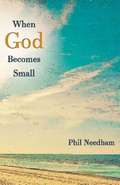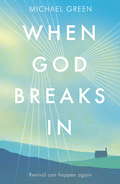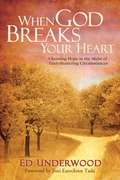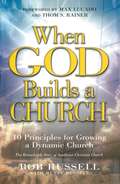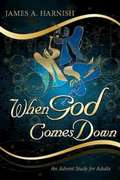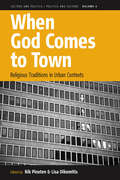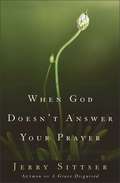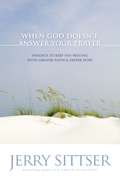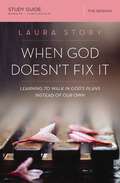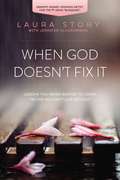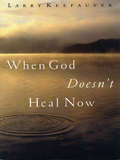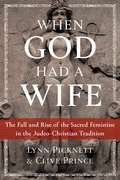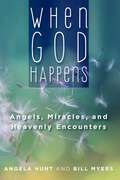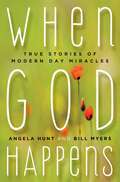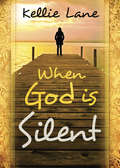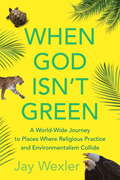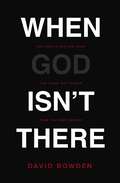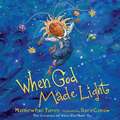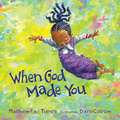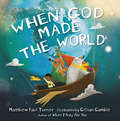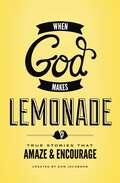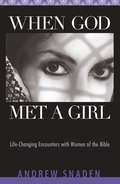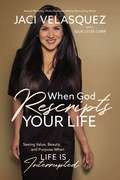- Table View
- List View
When God Becomes Small
by Phil NeedhamThe defining miracle of God’s greatness is the miracle of God becoming small. This miracle opens the door for us to know God and to experience fullness of life.From the author:"I am inviting you to consider the truth of God we rarely hear told. It is the surprising truth of his lowliness. It is God’s shocking humility."
When God Breaks In: Revival can happen again
by Canon Michael GreenDespite the growth of religion in general and Christianity in particular around the world, Western Europe and the UK remain overwhelmingly secular, with the church increasingly seen as backwards and irrelevant. In this provocative book well-known speaker and author Michael Green gives a snapshot of various different revivals from the UK's history, as well as describing how the early church started and focusing on various revivals around the world. Be bold, writes Michael - revival can happen again!
When God Breaks In: Revival can happen again
by Michael GreenDespite the growth of religion in general and Christianity in particular around the world, Western Europe and the UK remain overwhelmingly secular, with the church increasingly seen as backwards and irrelevant. In this provocative book well-known speaker and author Michael Green gives a snapshot of various different revivals from the UK's history, as well as describing how the early church started and focusing on various revivals around the world. Be bold, writes Michael - revival can happen again!
When God Breaks Your Heart
by Ed UnderwoodWhy is God letting this happen to me?If you have never asked this question, you someday will.There is perhaps no greater challenge to our faith than personal suffering. For pastor Ed Underwood this challenge came in the form of chronic leukemia. Though he prayed for and believed in God's healing, as the days slipped by and his pain became unbearable, Ed's heart was broken by a simple realization: The God who could do anything was not helping him. Yet a revelation from God's Word changed his heart and life forever.In this poignant journey from tragedy to hope, Ed takes a fresh look at the story of Lazarus and his sisters--a story that explores suffering through the eyes of our Lord and His people. You'll find comfort during difficulty, be inspired to ask for the impossible, and discover a God whose heart breaks with yours.
When God Builds a Church: 101 Principles for Growing a Dynamic Church
by Bob Russell Rusty RussellPastor Bob Russell shares the ten principles upon which Southeast Christian Church, one of the largest and fastest growing churches in America, was founded. He shares not only the story of one of the most amazing churches in America, but also what your church can become if you follow the principles and allow God to build your church.Can the church truly be the "city on a hill that cannot be hidden" that Jesus talked about in the Sermon on the Mount? Can it grow large enough to attract throngs of seekers and yet be loving enough to care for each individual that comes? Bob Russell, pastor of Southeast Christian Church—one of the largest and fastest growing churches in America—says that it most certainly can. But it can only be done when we are submissive to God's will and allow Him to build that church. In the pages of this far-sighted, uncompromising book, Bob Russell and his son Rusty share the ten principles upon which this remarkable church was founded. Throughout the book, you will see God's mighty power at work in a church that began in 1962 with only 50 members and has now grown to over 14,000 and has become a bustling "city on a hill" whose beaming faith powerfully impacts its community and the world. This book shares not only the story of one of the most amazing churches in America but also the story of what your church can become as you follow these ten time-tested principles and allow God to build your church.
When God Comes Down: An Advent Study for Adults
by Rev James A. HarnishWhen God Comes Down is a five-week study, providing one lesson for each week of Advent and one for Christmas. Each lesson includes a key Scripture, a brief reflection, discussion/reflection questions, a brief prayer, and a focus for the coming week. In this study, Harnish explores the meaning of the incarnation…God with us in human flesh. Often our Advent/Christmas journey is focused on us – our memories, feelings, relationships and experiences. This study puts the focus on God’s action in Jesus Christ. It encourages participants to think more deeply in terms of the biblical, theological, and spiritual meaning of the Nativity and to apply it to their own life experiences. The study looks at the stories of the primary biblical characters in the birth stories through whose lives the miracle of incarnation happened: Zechariah, Elizabeth, Joseph, Mary, and Jesus. Harnish also looks at a traditional character in nativity plays, one who is not mentioned in the Bible, the innkeeper. Through all these characters, he helps us claim for ourselves the reality of God's presence with us.
When God Comes To Town
by Rik Pinxten Lisa DikomitisAround 1800 roughly three per cent of the human population lived in urban areas; by 2030 this number is expected to have gone up to some seventy per cent. This poses problems for traditional religions that are all rooted in rural, small-scale societies. The authors in this volume question what the possible appeal of these old religions, such as Christianity, Judaism, or Islam could be in the new urban environment and, conversely, what impact global urbanization will have on learning and on the performance and nature of ritual. Anthropologists, historians and political scientists have come together in this volume to analyse attempts made by churches and informal groups to adapt to these changes and, at the same time, to explore new ways to study religions in a largely urbanized environment.
When God Doesn't Answer Your Prayer
by Jerry SittserA beloved husband dies of cancer. A child is kidnapped. A family is shattered by a fatal car accident. We pray for peace and protection in a world that seems to be falling apart. Often we experience or hear about spectacular answers to prayer. But where is God when the cry of our hearts seems to be answered with silence? When God Doesn't Answer Your Prayer explores the mysteries and paradoxes of unanswered prayer. Forged in the fires of his own quest following his own crushing experience of unanswered prayer, Jerry Sittser offers hard-won spiritual insights that affirm the greatness of God's love and concern for us, even when we do not fully understand why our prayers seem to go unanswered.
When God Doesn't Answer Your Prayer: Insights to Keep You Praying with Greater Faith and Deeper Hope
by Jerry L. SittserMore than a decade ago, Jerry Sittser prayed for the protection of his family, yet three of his loved ones—his daughter, his wife, and his mother—died in an automobile accident. What went wrong? “Why wasn’t my prayer answered?” he asks. “It is no longer an abstract question to me. What should we do and how should we respond when our prayers—prayers that seem right and true and good—go unanswered?” In When God Doesn’t Answer Your Prayer, Sittser continues exploring the issues he addressed in A Grace Disguised. He asks, “Why doesn’t God answer our prayers? What, if anything, can we do about it?” Sittser is intensely committed to exploring the Christian faith, especially when it doesn’t seem to “work.” In this thoughtful and beautifully written book, he moves beyond easy answers and religious formulas to explore the goodness and greatness of a God who cannot be controlled but can be trusted. When God Doesn’t Answer Your Prayer takes an honest and probing look at the problem of unanswered prayer. In doing so, it draws us ever deeper into a relationship with the God who is the end of all our prayers, the object of our faith, the one who fulfills our deepest longings.
When God Doesn't Fix It Study Guide: Learning to Walk in God's Plans Instead of Our Own
by Laura StoryLaura Story's life took an unexpected turn when her husband, Martin, was diagnosed with a brain tumor. The devastating news forever changed their lives and brought Laura's dreams of a fairy-tale life to an end. Yet her struggles to accept her new situation also brought her deeper joy and intimacy with God as she allowed him to rewrite her story. In this five-session curriculum, Laura examines the twists and turns that took place not only in her own life but also in the lives of many of the heroes of the faith. She reveals how God used crises in the lives of people such as Abraham, Sarah, David, and Paul to bring them closer to him and set them on the path he wanted them to take. She also shows how God used each of these individuals in spite of their flaws and brokenness. God may not fix everything in our lives. In fact, our situation might not ever change or get better. But we can know that God will lead us to a place where we are better because of it. Session Titles: Don't Be Surprised by Trouble Best-Made Plans When God Doesn't Fix It Why? The Question on Replay A Better Broken This study guide is designed for use with When God Doesn't Fix It: A DVD Study (sold separately) and includes leader helps, video discussion questions, Bible exploration questions, and personal study and reflection materials for in between sessions.
When God Doesn't Fix It: Lessons You Never Wanted to Learn, Truths You Can't Live Without
by Laura Story Jennifer SchuchmannIS IT POSSIBLE THAT GOOD THINGS CAN COME OUT OF OUR BROKEN DREAMS? Worship leader and recording artist Laura Story's life took an unexpected turn when her husband, Martin, was diagnosed with a brain tumor. Their lives would never be the same. Yes, with God all things are possible. But the devastating news was that no cure existed to restore Martin's short-term memory, eyesight, and other complications. The fairy-tale life Laura had dreamed of was no longer possible. And yet in struggling with God about how to live with broken dreams, Laura has found joy and a deeper intimacy with Jesus. Laura helps us understand we aren't the only ones whose lives have taken unexpected turns. She examines the brokenness of some of the heroes of our faith, and shows how despite their flaws and flawed stories, God was able to use them in extraordinary ways. And it was not because of their faith, but because of the faithfulness of their God. God may not fix everything. In fact, although your situation might not ever change or get better, with Jesus you can. "Our family has been ministered to by her vulnerability and willingness to walk in the valley and still say 'God, I Trust You.'" -- STEVEN CURTIS and MARY BETH CHAPMAN Grammy Award-Winning Artist and New York Times Bestselling Author "Laura is one of my heroes when it comes to trusting God. She's joyful, genuine, and faithful even though her story includes messy chapters. This book will be on my nightstand for a long time!" --LISA HARPER Author and Bible Teacher
When God Doesn't Heal Now
by Larry KeefauverGod has healed in the past and wants to heal now. But though they pray in faith, go to healing meetings, and strive to have enough faith, many are not healed as they would wish to be. When God Doesn't Heal Now examines the myths about healing that are built on partial truths and looks at the profound relationship between prayer, healing, and the sovereignty of God. This guide offers a balanced look at teachings on healing, faith healers, and ways to bring biblical clarity to beliefs that often foster guilt, defeat, and despair when believers are not immediately healed. When God Doesn't Heal Now is an encouraging book which affirms the biblical truth that God is our healer.
When God Had a Wife: The Fall and Rise of the Sacred Feminine in the Judeo-Christian Tradition
by Lynn Picknett Clive PrinceReveals the tradition of goddess worship in early Judaism and how Jesus attempted to restore the feminine side of the faith • Provides historical and archaeological evidence for an earlier form of Hebrew worship with both male and female gods, including a 20th-century discovery of a Hebrew temple dedicated to both Yahweh and the warrior goddess Anat • Explores the Hebrew pantheon of goddesses, including Yahweh&’s wife, Asherah, goddess of fertility and childbirth • Shows how both Jesus and his great rival Simon Magus were attempting to restore the ancient, goddess-worshipping religion of the Israelites Despite what Jews and Christians--and indeed most people--believe, the ancient Israelites venerated several deities besides the Old Testament god Yahweh, including the goddess Asherah, Yahweh&’s wife, who was worshipped openly in the Jerusalem Temple. After the reforms of King Josiah and Prophet Jeremiah, the religion recognized Yahweh alone, and history was rewritten to make it appear that it had always been that way. The worship of Asherah and other goddesses was now heresy, and so the status of women was downgraded and they were blamed for God&’s wrath. However, as Lynn Picknett and Clive Prince reveal, the spiritual legacy of the Jewish goddesses and the Sacred Feminine lives on. Drawing on historical research, they examine how goddess worship thrived in early Judaism and included a pantheon of goddesses. They share new evidence for an earlier form of Hebrew worship that prayed to both male and female gods, including a 20th-century archaeological discovery of a Hebrew temple dedicated to both Yahweh and the goddess Anat. Uncovering the Sacred Feminine in early Christianity, the authors show how, in the first century AD, both Jesus and his great rival, Simon Magus, were attempting to restore the goddess-worshipping religion of the Israelites. The authors reveal how both men accorded great honor to the women they adored and who traveled with them as priestesses, Jesus&’s Mary Magdalene and Simon&’s Helen. But, as had happened centuries before, the Church rewrote history to erase the feminine side of the faith, deliberately ignoring Jesus&’s real message and again condemning women to marginalization and worse. Providing all the necessary evidence to restore the goddess to both Judaism and Christianity, Picknett and Prince expose the disastrous consequences of the suppression of the feminine from these two great religions and reveal how we have been collectively and instinctively craving the return of the Sacred Feminine for millennia.
When God Happens: True Stories Of Modern Day Miracles
by Bill Myers Angela HuntPRAISE FOR THE WHEN GOD HAPPENS SERIES "Reading When God Happens is like receiving an intravenous dose of hope in a world parched by hopelessness. It will remind you not just to hope for miracles but to expect them."-- Melanie Hemry, Guideposts magazine writer and author of fifty-four books "A powerful read."-- Dimas Salaberrios, author of Street God "True stories like these require those who don't believe in angels ... to explain the unexplainable."-- Cal Thomas, syndicated columnist A diesel mechanic is smashed under the weight of a logging truck. A child's inner tube is sucked out of a peaceful stretch of water into a frothing patch of dangerous rapids. A woman searching for peace is met with an icy chill when she begins arranging runestones.... In all these stories, there is one common thread--God's angels are waiting and ready to powerfully intervene. If you have ever doubted the presence of angels or questioned whether God is still acting through them, this book will inspire you to look beyond your everyday perceptions. In the follow-up to their 2018 title When God Happens: True Stories of Modern Day Miracles, bestselling authors Angela Hunt and Bill Myers invite you into the miraculous--sharing nineteen true, firsthand testimonies of angelic appearances, perfectly placed protection, and unforeseen interventions that will encourage you in your faith and cause even the most skeptical minds to take a second look. Hear from a father whose family was saved from back-alley cutthroats by a mysterious Scotsman, a woman whose spiritual battle was inexplicably resolved through a tattooed pickup driver interested in potted plants, and a newlywed home economist whose generosity to an unexpected visitor transformed her life. If you have ever doubted what angels are, where they come from, or how God is working through them today, we pray these stories will open your eyes to the mighty work that is done when God happens.
When God Happens: True Stories of Modern Day Miracles
by Bill Myers Angela HuntA car flips over on the highway and bursts into flames. A father hears devastating news about his unborn child. A teenage girl follows a friend to a dangerous party. Then God happens. If you have ever doubted the miraculous power of God, prepare to be astonished. Here, real people share true stories of modern-day miracles—moments of divine intervention when the hand of God was briefly and beautifully revealed. Edited by bestselling authors Angela Hunt and Bill Myers, the eight stories in When God Happens include first-hand accounts of medical healing, angelic visitation, and demonic possession. As Hunt and Myers write, these testimonies “are a reminder that the God who reached down to touch those He loved in Bible days has not changed. He has not turned His back on us or left us to our own devices. As Scripture also states, ‘[He] is the same yesterday, today, and forever.’” We pray these stories inspire you to look to God for the deepest needs in your life as you discover how He has worked in the lives of others just like you.
When God Is Silent
by Kellie LaneWhat do you do when you’ve prayed and prayed and there seems to be no answer? Kellie Lane knows what it is like to feel as though you are holding a ticket for a ride that’s never going to arrive. Through personal experience and Bible study she has learned how to hold on to heaven’s promises--for yourself or others--when it seems like all hell is breaking loose. You will discover why you may be waiting, where God is in this difficult season, and what you can do to cooperate with His plans and purposes for you. If it feels like the heavens have turned to brass, let prayer warrior Kellie Lane show you how to position yourself to receive the gold that is coming your way through the fire of refinement.
When God Isn't Green: A World-Wide Journey to Places Where Religious Practice and Environmentalism Collide
by Jay WexlerIn this lively, round-the-world trip, law professor and humorist Jay Wexler explores the intersection of religion and the environment. Did you know that * In Hong Kong and Singapore, Taoists burn paper money to appease "hungry ghosts," filling the air with smoke and dangerous toxins? * In Mumbai, Hindus carry twenty-foot-tall plaster of Paris idols of the elephant god Ganesh into the sea and leave them on the ocean floor to symbolize the impermanence of life, further polluting the scarce water resources of western India? * In Taiwan, Buddhists practicing "mercy release" capture millions of small animals and release them into inappropriate habitats, killing many of the animals and destroying ecosystems? * In Central America, palm frond sales to US customers for Palm Sunday celebrations have helped decimate the rain forests of Guatemala and southern Mexico? * In New York, Miami, and other large US cities, Santeria followers sprinkle mercury in their apartments to fend off witches, poisoning those homes for years to come? * In Israel, on Lag B'omer, a holiday commemorating a famous rabbi, Jews make so many bonfires that the smoke can be seen from space, and trips to the emergency room for asthma and other pulmonary conditions spike? Law professor and humorist Jay Wexler travels the globe in order to understand the complexity of these problems and learn how society can best address them. He feasts on whale blubber in northern Alaska, bumps along in the back of a battered jeep in Guatemala, clambers down the crowded beaches of Mumbai, and learns how to pluck a dead eagle in Colorado, all to answer the question "Can religious practice and environmental protection coexist?"
When God Isn't There: Why God Is Farther than You Think but Closer than You Dare Imagine
by David BowdenWhy does God feel so far away? Why is my worship so empty? Has God left me? David Bowden knows these questions firsthand, having wrestled for years with God's apparent absence and studying what the Bible says about it. In this new book, Bowden tackles the subject head-on, finding the key to understanding it in the Bible's depiction of a God who is infinitely far from us, free to move where he wants, but who chooses to come near in the person of Jesus. A resource of encouragement for those who struggle with feeling God's absence and a wake-up call to those who take God's presence for granted, When God Isn't There will forever change your understanding of why God sometimes seems to vanish and how he can be found again.
When God Made Light
by David Catrow Matthew Paul TurnerFrom the author and illustrator of the best-selling When God Made You comes a new illuminating message about God's design affirming young readers.'Let there be light!' that's what God said. And light began shining and then started to spread." Wild and creative illustrations from top children's illustrator David Catrow pair with Matthew Paul Turner's lyrical verse in this message of a God-made light that cuts through darkness to bring vision and hope to all young readers. This light radiates, chasing away the shadows, providing the wonder and fun of stargazing or firefly chasing. Most important, this light appears in each child--an inner God-given spark that grows and will be used to change the world.
When God Made You
by David Catrow Matthew Paul TurnerYOU, you… God thinks about you.God was thinking of you long before your debut.From early on, children are looking to discover their place in the world and longing to understand how their personalities, traits, and talents fit in. The assurance that they are deeply loved and a unique creation in our big universe is certain to help them spread their wings and fly. Through playful, charming rhyme and vivid, fantastical illustrations, When God Made You inspires young readers to learn about their own special gifts and how they fit into God’s divine plan as they grow, explore, and begin to create for themselves. ‘Cause when God made YOU, somehow God knewThat the world needed someone exactly like you!
When God Made the World
by Matthew Paul TurnerFrom the author of the bestselling children's book When God Made You comes a rhythmic, whimsical journey through creation--for little readers who love science and wonder and the beginnings of all things.For spiritual parents who are looking for a different kind of creation book, Matthew Paul Turner's When God Made the World focuses on the complex way that God created our vast and scientifically operating universe, including the biodiversity of life on our planet and the intricacies of a vast solar system. Scottish illustrator Gillian Gamble brings the natural world to vibrant life with rich colors and poignant detail certain to stretch young minds and engage imaginations.Planet Earth, God made a blue and green sphere,And designed it to orbit the sun once a year.God made daytime and nighttime, climates and seasons,And all kinds of weather that vary by region.God made continents and oceans, islands and seas,A north and south pole that God put in deep freeze.God carved rivers and brooks, mountains and caves,Made beaches with sand and huge crashing waves.God made tropics and plateaus, glaciers and meadows,marshes and tundras and erupting volcanos.
When God Makes Lemonade: True Stories That Amaze and Encourage
by Don JacobsonDo you know someone who needs some encouragement? Perhaps that someone is you.In When God Makes Lemonade, author Don Jacobson has collected real-life stories from around the world that show everyday folks discovering unexpected sweetness in the midst of sour circumstances. Some are funny, others are sobering, and more than a few will bring tears of amazement. But these true stories all have one thing in common: hope.There's no question that life gives us "lemons," like issues with health, employment, and relationships. But when those lemons become lemonade, it's as refreshing as a cold drink on a hot summer day.It's true that in life "stuff" happens, but as you'll see in these stories, Lemonade Happens too!
When God Met a Girl
by Andrew SnadenWhen God Met a Girl portrays vivid snapshots of the loving meetings between Jesus and the women he encountered. Jesus was never dominant or insensitive, but was a healer who encouraged and empowered these women. Be encouraged to imitate Jesus in your relationships with others and to have a deeper understanding of grace, God's life-changing love for women, and the realization that true self-esteem can only come from a committed relationship with him.
When God Prays
by Skip HeitzigWHY WOULD GOD PRAY? Throughout his life on earth, Jesus demonstrated his dependence on the Father by spending time in prayer. In the final hours before his death, he prayed in the presence of his disciples. This prayer of Jesus is a model for some profound lessons in Christian living: How can we talk to God when life is reduced to ashes? How can we live our lives with the proper ambition of glorifying God? How can we remain spiritually relevant in a spiritually hostile culture? How can we prepare for heaven while living on earth? In When God prays, the veil of intimacy between Father and Son is drawn back and we gaze into the Holy of Holies, into the very heart of God. But as we linger on such holy ground, we'll do more than just listen; we will learn effective ways to enhance our own communication with God.
When God Rescripts Your Life: Seeing Value, Beauty, and Purpose When Life Is Interrupted
by Jaci VelasquezMuch of what happens in our lives is not what we planned, not what we expected, and certainly not what we would have chosen. At a young age, Jaci Velasquez’s singing career rocketed to stardom, and her marriage thrived—then both suddenly crashed. Losing her reputation, her record label, and even some of her most-treasured relationships, Jaci began a long, healing journey from thinking of herself not as a Christian music darling or a broken young woman but as a beloved child of God. Today, her renewed faith carries her through a resurrected career, the adventures of a second marriage, and the ups-and-downs of being a mother of a child who has autism. When God Rescripts Your Life is Jaci’s exploration of the lessons she’s learned living a story full of mistakes and grace, rejection and contentment, worldly success and spiritual rest. Drawing on lessons from biblical characters such as Aaron, Joseph, and Paul, as well as from illustrations from her own life, Jaci reminds us how God loves to rewrite pain and weakness into a glorious tale of redemption. The most difficult parts of life don’t need to be removed; they need to be rescripted.
